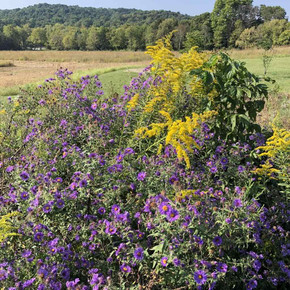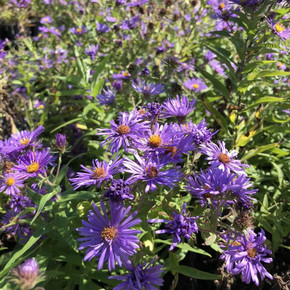
Aster laevis (Symphyotrichum) - SMOOTH ASTER
Clump forming late blooming aster, doesn't spread aggressively (but can seed around a bit). In time develops into shrubby looking upright plant.
Fairly large blue flowers, grayish smooth leaves.
Excellent wildlife support. Easy to grow, but can be choked by strong, too vigorous and competitive neighbors.
Blooming Time: August/September - October
Size: 3-3.5’ tall x 1.5-2' wide
USDA Zones: 3 to 9
Culture: full to part sun, tolerant and adaptable to many types of soil including shallow, rocky soils
Moisture Needs: medium-moist to medium-dry. Established plants are drought tolerant. Avoid waterlogged soils.
Origin: the native Aster laevis is found throughout the US and most of Canada (USDA distribution map) growing in mesic prairies, savannas, well drained woodlands, dry open woods and disturbed road embankments or thickets
Deer/Rabbit Resistant: mostly yes (if deer not overpopulated) / mostly yes, but young and more palatable leaves can be browsed by both and by groundhog too
Attracts Butterflies or Pollinators: offersnectar and pollen of the flowerheads to honeybees and many native bees (bumblebees, cuckoo bees, digger bees, leaf-cutting bees, Halictid bees, Andrenid bees), Sphecid wasps, Syrphid flies, Muscid flies, butterflies, and skippers. Some insects feed destructively on the various parts of the plant (leaf beetle, the Red-spotted Aster Mirid, larvae of a leaf-mining fly, larvae of the Papery Blister Gall Midge, the Short-winged Meadow Katydid, caterpillars of moths like Wavy-lined Emerald, The Asteroid and Blatchley's Walkingstick.
Ruffed Grouse and Wild Turkey (upland birds) feed on both the leaves and seeds of asters. The Tree Sparrow and White-footed Mouse also eat the seeds.
Attracts Hummingbirds: no
Pot Size: 3.5" x 4" pot
Picture copyright : Kathleen Houlahan Chayer, Commons Wikimedia
Plant combination : Meets in bloom and nicely contrasts with late blooming yellow flowers of Chrysopsis mariana (Maryland Aster), Chrysopsis villosa, Helianthus (perennial sunflowers), usually overlaps with late blooming Rudbeckia (R. fulgida var. fulgida,R. subtomentosa, R. triloba) and various Solidago (Goldenrod).
Good companions are various prairie plants and even the "common conventional" plants. Looks great with more robust structures or plants with larger leaves or flowers like Echinacea, Parthenium integrifolium, Rudbeckia, Silphium, Yucca, or Peonia. Great combos are traditionally with grasses like Andropogon, Calamagrostis, Eragrostis, Panicum, Muhlenbergia, Schizachyrium.

Aster laevis (Symphyotrichum) - SMOOTH ASTER
Clump forming late blooming aster, doesn't spread aggressively (but can seed around a bit). In time develops into shrubby looking upright plant.
Fairly large blue flowers, grayish smooth leaves.
Excellent wildlife support. Easy to grow, but can be choked by strong, too vigorous and competitive neighbors.
Blooming Time: August/September - October
Size: 3-3.5’ tall x 1.5-2' wide
USDA Zones: 3 to 9
Culture: full to part sun, tolerant and adaptable to many types of soil including shallow, rocky soils
Moisture Needs: medium-moist to medium-dry. Established plants are drought tolerant. Avoid waterlogged soils.
Origin: the native Aster laevis is found throughout the US and most of Canada (USDA distribution map) growing in mesic prairies, savannas, well drained woodlands, dry open woods and disturbed road embankments or thickets
Deer/Rabbit Resistant: mostly yes (if deer not overpopulated) / mostly yes, but young and more palatable leaves can be browsed by both and by groundhog too
Attracts Butterflies or Pollinators: offersnectar and pollen of the flowerheads to honeybees and many native bees (bumblebees, cuckoo bees, digger bees, leaf-cutting bees, Halictid bees, Andrenid bees), Sphecid wasps, Syrphid flies, Muscid flies, butterflies, and skippers. Some insects feed destructively on the various parts of the plant (leaf beetle, the Red-spotted Aster Mirid, larvae of a leaf-mining fly, larvae of the Papery Blister Gall Midge, the Short-winged Meadow Katydid, caterpillars of moths like Wavy-lined Emerald, The Asteroid and Blatchley's Walkingstick.
Ruffed Grouse and Wild Turkey (upland birds) feed on both the leaves and seeds of asters. The Tree Sparrow and White-footed Mouse also eat the seeds.
Attracts Hummingbirds: no
Pot Size: 3.5" x 4" pot
Picture copyright : Kathleen Houlahan Chayer, Commons Wikimedia
Plant combination : Meets in bloom and nicely contrasts with late blooming yellow flowers of Chrysopsis mariana (Maryland Aster), Chrysopsis villosa, Helianthus (perennial sunflowers), usually overlaps with late blooming Rudbeckia (R. fulgida var. fulgida,R. subtomentosa, R. triloba) and various Solidago (Goldenrod).
Good companions are various prairie plants and even the "common conventional" plants. Looks great with more robust structures or plants with larger leaves or flowers like Echinacea, Parthenium integrifolium, Rudbeckia, Silphium, Yucca, or Peonia. Great combos are traditionally with grasses like Andropogon, Calamagrostis, Eragrostis, Panicum, Muhlenbergia, Schizachyrium.






